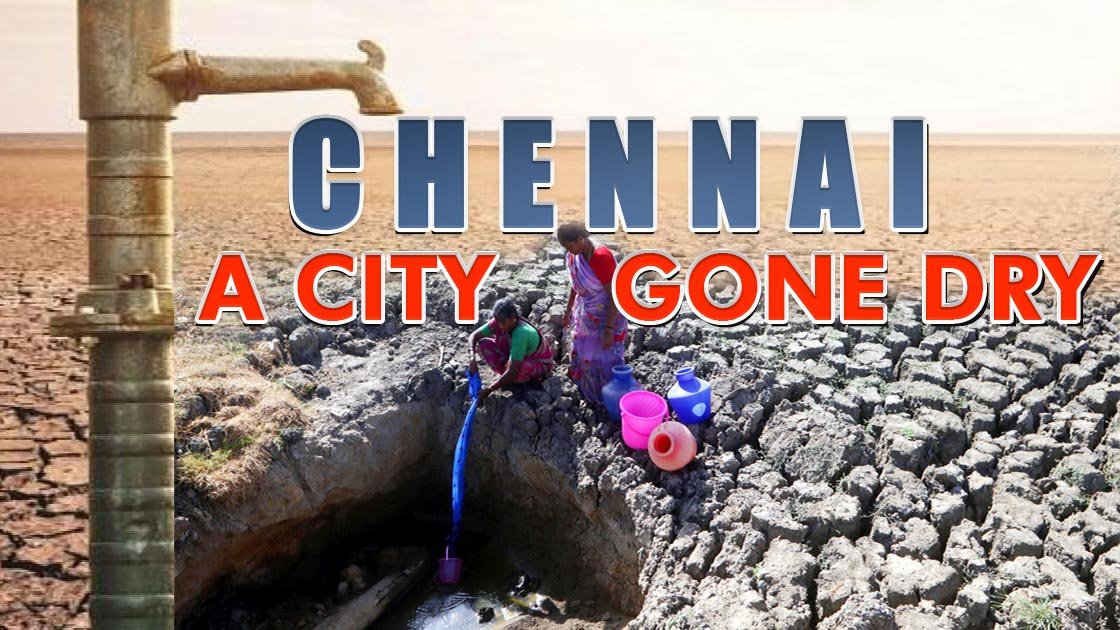Chennai, often regarded as ‘Detroit of India’ aspires to grow into a global economic hub. But its dreams and aspirations have come to a standstill as the city is having the worst water crisis in its history. The four main reservoirs of the city have gone dry, owing to absence of rain in last 200 days, barring a few
drops in last week and it has caught the city in a catch-22 situation. But is it the erratic monsoon that caused this menace? Or is it a mere excuse of our satraps just to pass the bucks and avoid the onus of them? Bit of both perhaps.
In the yore, water scarcity in Western Rajasthan or North-Western Gujarat or Central India was a familiar phenomenon, but in the other parts of the country was a few and far between occurrence. But how could Chennai, situated in Coromandel Coast, that is supposed to get rain twice a year, both by south-west monsoon and retreating monsoon possibly go dry? It was less than four years ago, the city was hit with one of the most severe floods, and the excess water from same reservoirs had to be released. It was the siltation of the reservoirs and encroachment of the wetlands and catchment areas in the city that caused the flood and it is the same reason that resulted into the drought like situation. For the sake of urbanization, in last few years over 300 lakes in Chennai have disappeared. Early this year, when water tankers in Chennai began to replace the piped water in many areas, it was a clear warning sign which many have failed to be perceive. Now, people are spending a fourth of their income over the water, though the supply is erratic and people have to stand in queue from midnight to have a few pots of water. Nobody has been spared – the water crisis has brought the rich and poor, homes and industries to their knees. The city’s famous IT hub, which is heavily dependent upon water tankers, took the worst hit. Most of the companies have advised the employees to work from home. The hotel and construction works are also hit most. The restaurants are planning to stop offering lunch in order to save a few drops.
The state govt. has called this water scarcity “exaggerated” and took a few measures to break this cul-desac. Water from desalination plants and from Vellore district is being brought to Chennai. Kerala has also offered wagons of water, which has been accepted by Tamil Nadu govt. But is it not this tendency to solve any problem by fire-fighting strategy rather than a properly planned systematized solution that is causing this sort of perils?
Rain Water Harvesting (RWH) was proposed in Chennai in way back in 2000 and supposed to be implemented since 2003. And here we are sixteen years later, back to square one without a single govt. building in Chennai with RWH facility. In a nutshell, it is the failure of the water governance coupled with a truant monsoon that has left the city high and dry.
What is happening in Chennai might only be the tip of the iceberg. According to the NITI Aayog report, 21 cities including Delhi, Bengaluru, Hyderabad and Chennai will run out of ground water by 2020. So, a much larger threat is looming over the whole country that needs holistic and widely resonant solutions. After the election, there was scepticism about whether the newly formed govt. will address the issue properly or will it just provide the lip-service?
In a welcome move, the central govt. has created a new ministry “Ministry of Jal Shakti” in order to counter this problem. It has been decided that every govt. building in Delhi will start rain water harvesting and in each electoral booth across the country, at least five saplings are to be planted. Tax on ground water uses except for agricultural uses was also proposed by the central govt. earlier as well as this year but that is yet to be materialized. Legislation of strict ground water uses along with public awareness, followed by proper implementation of the laws is what must be done to avoid the threat hovering like the Sword of Damocles.
